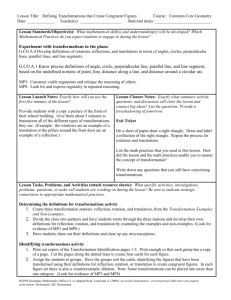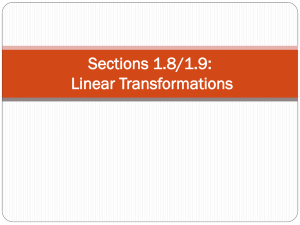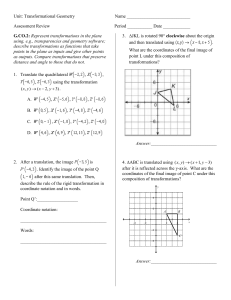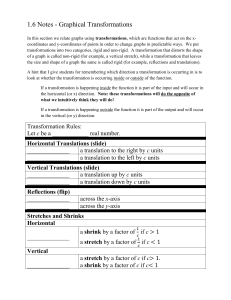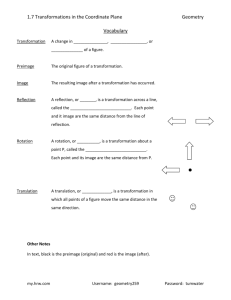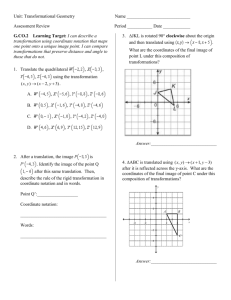Geometry: Sequences of Transformations Lesson Plan
advertisement
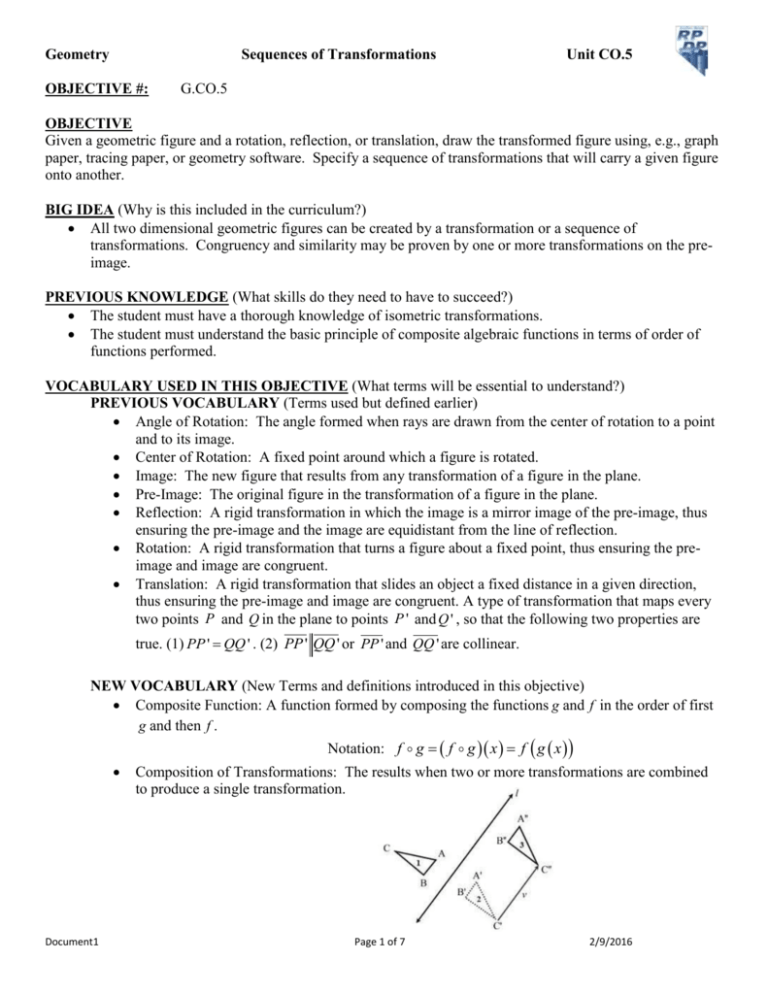
Geometry Sequences of Transformations OBJECTIVE #: Unit CO.5 G.CO.5 OBJECTIVE Given a geometric figure and a rotation, reflection, or translation, draw the transformed figure using, e.g., graph paper, tracing paper, or geometry software. Specify a sequence of transformations that will carry a given figure onto another. BIG IDEA (Why is this included in the curriculum?) All two dimensional geometric figures can be created by a transformation or a sequence of transformations. Congruency and similarity may be proven by one or more transformations on the preimage. PREVIOUS KNOWLEDGE (What skills do they need to have to succeed?) The student must have a thorough knowledge of isometric transformations. The student must understand the basic principle of composite algebraic functions in terms of order of functions performed. VOCABULARY USED IN THIS OBJECTIVE (What terms will be essential to understand?) PREVIOUS VOCABULARY (Terms used but defined earlier) Angle of Rotation: The angle formed when rays are drawn from the center of rotation to a point and to its image. Center of Rotation: A fixed point around which a figure is rotated. Image: The new figure that results from any transformation of a figure in the plane. Pre-Image: The original figure in the transformation of a figure in the plane. Reflection: A rigid transformation in which the image is a mirror image of the pre-image, thus ensuring the pre-image and the image are equidistant from the line of reflection. Rotation: A rigid transformation that turns a figure about a fixed point, thus ensuring the preimage and image are congruent. Translation: A rigid transformation that slides an object a fixed distance in a given direction, thus ensuring the pre-image and image are congruent. A type of transformation that maps every two points P and Q in the plane to points P ' and Q ' , so that the following two properties are true. (1) PP ' QQ ' . (2) PP ' QQ ' or PP ' and QQ ' are collinear. NEW VOCABULARY (New Terms and definitions introduced in this objective) Composite Function: A function formed by composing the functions g and f in the order of first g and then f . Notation: f g f g x f g x Document1 Composition of Transformations: The results when two or more transformations are combined to produce a single transformation. Page 1 of 7 2/9/2016 Geometry Sequences of Transformations Unit CO.5 Sequence of Transformations: The order in which a composite transformation is performed. SKILLS (What will they be able to do after this objective?) Students will be able to perform composite transformations. Students will be able to identify the sequence of transformations performed from a pre-image to its resulting image. Students will be able to describe what type of single translation is formed by reflecting a figure over parallel lines. Students will be able to describe what type of single translation is formed by reflecting a figure over intersecting lines. SHORT NOTES (A short summary of notes so that a teacher can get the basics of what is expected.) A double reflection over parallel lines can be performed by 1 single translation. A double reflection over intersecting lines can be performed by 1 single rotation. Given a pre-image and its image, students should be able to describe the transformation, or sequences of transformations, that maps one onto the other. Activity This activity can be completed using patty paper. Each student should have their own piece of patty paper and a ruler. It is recommended to complete this activity with your students. Transformation Activity 1 Draw a small scalene triangle in the upper right hand corner of your paper. Name it Δ 𝐴𝐵𝐶. Fold your paper near Δ 𝐴𝐵𝐶 so that the crease does not intersect Δ 𝐴𝐵𝐶. Draw and label the crease line 𝑚. Fold Δ 𝐴𝐵𝐶 over 𝑚 and trace Δ 𝐴𝐵𝐶 to create Δ 𝐴′𝐵′𝐶′ on the same side of the paper. What type of transformation is this? Reflection over m 5) Create line 𝑝 by folding 𝑚 onto itself. What kind of lines are 𝑚 and 𝑝? Perpendicular Lines 6) Mark •T on 𝑝 below Δ 𝐴′𝐵′𝐶′. 7) Fold 𝑝 onto itself so that the line created intersects at T. Call the new line 𝑛. How do lines 𝑚 and 𝑛 appear? Parallel Lines 8) Fold Δ 𝐴′𝐵′𝐶′ over 𝑛 to create Δ 𝐴"𝐵"𝐶". What type of transformation is this? Reflection over n 9) Compare Δ 𝐴𝐵𝐶 and Δ 𝐴"𝐵"𝐶". What type of transformation is this? Translation How was this transformation made? From two reflections over parallel lines 10) With a ruler (yes, a ruler) measure the distance from 𝐴 to 𝐴" (cm). 𝐴𝐴" = answers will vary Why don’t we notate with ̅̅̅̅̅ 𝐴𝐴"? It is the measurement of a segment, not the segment Find 𝐵𝐵" will be the same as AA” (and 𝐶𝐶" will be the same as AA”) What do you notice? They are all the same distance 11) Now measure the distance from 𝑚 to 𝑛 along 𝑝. Note: When we measure the distance between two lines, we measure the ______________ segment connecting the lines. Perpendicular Distance between 𝑚 and 𝑛. Answers will vary What do you notice? It is half of the previous distances (distance from the pre-image to the double reflection image) 1) 2) 3) 4) Document1 Page 2 of 7 2/9/2016 Geometry Sequences of Transformations Unit CO.5 Transformation Activity 2 Draw a small scalene triangle in the upper left hand corner of your paper. Label it Δ 𝐴𝐵𝐶. Fold your paper so that the crease is near Δ 𝐴𝐵𝐶 but does not intersect the triangle. Be sure the crease ends at opposite sides of the paper. Do not crease a perpendicular line to the sides of the paper. Make it angled. 3) Label the crease line l. 4) Trace the reflection over line l and label it Δ 𝐴′𝐵′𝐶′. 5) Use a straight edge to draw line below Δ 𝐴′𝐵′𝐶′ and that intersects line l. Label it line 𝑚. 6) Reflect Δ 𝐴′𝐵′𝐶′ over line 𝑚 and label in Δ 𝐴"𝐵"𝐶". 7) Label the intersection of l and 𝑚 as point F. 8) Draw a segment from F to any vertex on Δ 𝐴𝐵𝐶. 9) Now draw a segment from F to the corresponding vertex on Δ 𝐴"𝐵"𝐶". 10) Measure the angle created by the segments from step 8 and 9. answers will vary 11) Measure the angle created by l and m. should be half of the answer to #10 What do you notice about the angle measures of steps 10 and 11? It is half 12) We did two transformations (reflections) to get from Δ 𝐴𝐵𝐶 to Δ 𝐴"𝐵"𝐶". Could we have done one single transformation? If so, which transformation? Rotation 1) 2) Use this example to check for understanding. Provide students with a coordinate plane. Draw Δ ABC at A(1, 1), B(2, 3), C(-1, 2). a) Reflect Δ ABC over the x-axis and label Δ A’B’C’. A’(_____, _____) A '(1, 1) B’(_____, _____) B ' 2, 3 C’(_____, _____) C ' 1, 2 b) Reflect Δ A’B’C’ over y = -4 and label Δ A’’B’’C’’. A’’(__1___, __-7___) B’’(__2___, __-5___) C’’(__-1___, __-6___) A '(1, 7) B ' 2, 5 C ' 1, 6 c) Describe the transformation from Δ ABC to Δ A’’B’’C’’ (ignoring Δ A’B’C’) and write this transformation using coordinate notation. Single Transformation: Translation x, y x, y – 8 Document1 Page 3 of 7 2/9/2016 Geometry Sequences of Transformations Unit CO.5 MISCONCEPTIONS (What are the typical errors or difficult areas? Also suggest ways to teach them.) Be sure that the students understand the notation for the different transformations. The order in which you perform a sequence of transformation matters. o For example: Given the following composite transformation, you would perform the dilation first and then the reflection. 𝑅𝑥=𝑦 °𝐷0,2 (𝑥, 𝑦) FUTURE CONNECTIONS (What will they use these skills for later?) These composite transformations will be used throughout the year to help build understanding of similarity and congruency. ADDITIONAL EXTENSIONS OR EXPLANATIONS (What needs greater explanation?) When a translation and a reflection are performed to produce a transformation, the order in which the translation and reflection are performed may or may not affect the image. The comparison between composite transformation and composite algebraic functions should be emphasized. ASSESSMENT ITEMS (What questions would evaluate these skills?) 1) The diagram shows regular hexagon ABCDEF with center O. A F B O E C D For each part, fill in the blank. (a) _____ is the image of A under a 60° rotation about O. (b) The figure is reflected across ⃡𝐴𝐷. The pre-image of E is _____. (c) F is the image of D when the figure is rotated _____° about O. ⃡ . That image maps to F when reflected across_______. (d) B is first reflected across 𝐹𝐶 Document1 Page 4 of 7 2/9/2016 B C 120 ⃡ 𝐵𝐸 Geometry Sequences of Transformations Unit CO.5 2. Use the figure. B y A A’ C C’ B’ F E D x (a) Transform ABC by reflecting it across the y-axis to produce ABC . (b) Describe a transformation, or composition of transformations, that maps ABC to DEF . Reflection over y = 2.5 (c) Describe a single transformation that maps ABC to DEF . By connecting the corresponding vertices of the two triangles, the intersection of the segments is the center of rotation. Therefore, this is a 𝑅(0,2.5),180° From CCSD Geometry Honors Semester 1 Practice Exam 2012 – 2013 1. What is the image of the point (–4, 6) under the transformation T x, y y, x ? (A) (6, 4) (B) (–6, –4) (C) (4, 6) (D) (–4, –6) 2. A figure is rotated about the origin by 180°, then is translated 4 units right and one unit up. Which describes the results of the two transformations? (A) x, y x 4, y 1 (B) (C) x, y x 4, y 1 x, y y 4, x 1 x, y y 4, x 1 (D) 3. The point A(4, 3) is rotated –90° about the origin. In which quadrant is A' ? (A) I (B) II (C) III (D) IV Document1 Page 5 of 7 2/9/2016 Geometry Sequences of Transformations Unit CO.5 4. A figure is reflected across the line y = 2, then reflected across the line y = 4. Which single transformation results in the same image? (A) a reflection across the line y = 3 (B) a reflection across the line y = 6 (C) a translation 2 units up (D) a translation 4 units up 5. Point A is the image of point A under a transformation T. Line l is the perpendicular bisector of AA at point M. Which describes the transformation T? (A) a reflection across line l (B) a 90° rotation about M (C) a translation by the vector from A to M (D) a dilation about M with scale factor 2 For questions 6 - 7, a transformation S is defined as x, y 3x, y 1 . 6. The pre-image of A 3, 6 under S is A 9, 5 . (A) True (B) False 7. S is an isometry. (A) True (B) False 8. Given point A is located at (1, 3). What is the final image of A after this series of transformations? (1) Reflect A across the y-axis. (2) Translate the image such that x, y x 4, y 2 . (A) (–1, –3) (B) (–3, 5) (C) (–3, –1) (D) (–5, 5) For questions 9 - 12, determine if the mapping is an isometry. 9. x, y x, y 2 is an isometry. (A) True (B) False 10. x, y x, y is an isometry. (A) True (B) False 11. x, y y, x is an isometry. (A) True (B) False 12. x, y 2x, y is an isometry. (A) True (B) False Document1 Page 6 of 7 2/9/2016 Geometry Sequences of Transformations Unit CO.5 For questions 13 - 14, use the diagram which shows ABC has been reflected across an unknown line n, then reflected across line m to produce ABC. y C A B B m x A C 13. The equation of line n is x = –0.5. (A) True (B) False 14. If ABC were reflected across line m first, then reflected across line n to produce ABC, the equation of line n would be x = –0.5. (A) True (B) False 15. In the diagram, 𝑔 ∥ ℎ and B lies on line g. 10 cm 5 cm B C A g h The figure ABC is reflected across line g, and its image is reflected across line h. What is the distance from line g to the final image of point A? (A) 5 cm (B) 15 cm (C) 20 cm (D) 25 cm Document1 Page 7 of 7 2/9/2016

